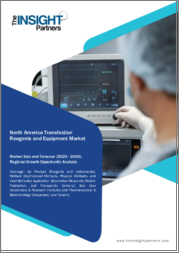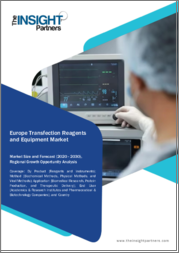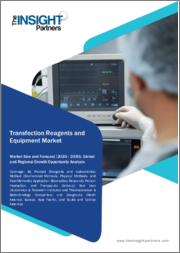
|
시장보고서
상품코드
1467759
트랜스펙션 시약 및 장비 시장 보고서 : 제품, 기술, 용도, 최종사용자, 지역별(2024-2032년)Transfection Reagents and Equipment Market Report by Product, Technology, Application, End User, and Region 2024-2032 |
||||||
2023년 전 세계 트랜스펙션 시약 및 장비 시장 규모는 9억 7,110만 달러에 달했습니다. 향후 IMARC Group은 2032년까지 시장 규모가 17억 6,690만 달러에 달해 2024-2032년 사이 6.7%의 연평균 성장률(CAGR)을 기록할 것으로 예상했습니다.
트랜스펙션 시약 및 장비는 in vitro 및 in vivo에서 진핵 세포의 유전자 발현을 조절하는 데 도움이 됩니다. 이러한 시약은 연구자들이 안정적인 세포주를 만들고, 발현용 유전자 삽입물이나 저분자 간섭 RNA(siRNA)를 가진 데옥시리보핵산(DNA) 플라스미드를 도입할 수 있게 해줍니다. 현재 단백질 합성, 세포 성장 및 발달, 유전적 기능 연구를 위한 실행 가능한 분석 도구로 사용되고 있습니다. 또한, 트랜스페션 시약 및 장비는 충분한 양의 재조합 인간 치료용 단백질을 비용 효율적이고 신속하게 생산할 수 있기 때문에 r-단백질, 항체 및 백신용 바이러스 벡터의 생산에도 적용되고 있습니다.
트랜스펙션 시약 및 장비 시장 동향:
코로나바이러스 감염증(COVID-19)이 전 세계적으로 확산됨에 따라 많은 국가의 정부기관이 백신 접종을 장려하는 데 주력하고 있습니다. 그러나 새로운 변종 바이러스의 출현으로 인해 백신이 제공하는 방어 및 면역은 수명이 짧습니다. 이에 따라 혁신적인 전략을 개발하거나 기존 치료법을 재사용하여 바이러스 감염과 싸우기 위해 트랜스페션 시약 및 장비의 필요성이 증가하고 있습니다. 이와는 별도로, 정밀의료와 양질의 종양학 치료에 대한 수요 증가와 함께 새로운 암 변이체의 신속한 검출은 암 연구 및 약물 개발에서 트랜스펙션 시약 및 장비의 채택을 촉진하고 있습니다. 또한, 유전적 문제로 인한 희귀 질환을 치료하기 위해 유전자 치료제가 사용되기 시작하면서 시장 성장을 촉진하고 있습니다. 또한, 전 세계적으로 교통 사망 사고가 증가함에 따라 손상된 조직의 기능적 대체물을 개발하기 위한 조직 공학에 대한 수요가 크게 증가하고 있습니다. 이는 시장 성장을 촉진하고 있습니다. 이 외에도 최근 이식 기술의 발전과 제약 및 생명공학 부문에 대한 투자 증가가 시장을 견인할 것으로 예상됩니다.
본 보고서에서 다루는 주요 질문들
- 2023년 트랜스펙션 시약 및 장비 세계 시장 규모는?
- 2024-2032년 사이 전 세계 트랜스펙션 시약 및 장비 시장의 예상 성장률은?
- 전 세계 트랜스페션 시약 및 장비 시장을 이끄는 주요 요인은 무엇인가?
- COVID-19가 전 세계 트랜스페션 시약 및 장비 시장에 미치는 영향은?
- 전 세계 트랜스페션 시약 및 장비 시장의 제품별 분류는 어떻게 되는가?
- 기술별 트랜스페션 시약 및 장비 세계 시장 현황은?
- 전 세계 트랜스페션 시약 및 장비 시장의 용도별 분류는?
- 최종사용자별 트랜스페션 시약 및 장비 세계 시장 현황은?
- 전 세계 트랜스페션 시약 및 장비 시장의 주요 지역은 어디인가?
- 전 세계 트랜스페션 시약 및 장비 시장의 주요 진출 기업은?
목차
제1장 서문
제2장 조사 범위와 조사 방법
- 조사 목적
- 이해관계자
- 데이터 소스
- 1차 정보
- 2차 정보
- 시장 추정
- 상향식 접근
- 하향식 접근
- 조사 방법
제3장 주요 요약
제4장 소개
- 개요
- 주요 업계 동향
제5장 세계의 트랜스펙션 시약 및 장비 시장
- 시장 개요
- 시장 실적
- COVID-19의 영향
- 시장 예측
제6장 시장 내역 : 제품별
- 시약
- 장비
제7장 시장 내역 : 기술별
- 생화학 기반 트랜스펙션
- 물리적 트랜스펙션
- 바이러스 벡터 기반 트랜스펙션
제8장 시장 내역 : 용도별
- 바이오메디컬 조사
- 단백질 생산
- 치료 딜리버리
제9장 시장 내역 : 최종사용자별
- 제약·바이오 기업
- 학술·연구기관
제10장 시장 내역 : 지역별
- 북미
- 미국
- 캐나다
- 아시아태평양
- 중국
- 일본
- 인도
- 한국
- 호주
- 인도네시아
- 기타
- 유럽
- 독일
- 프랑스
- 영국
- 이탈리아
- 스페인
- 러시아
- 기타
- 라틴아메리카
- 브라질
- 멕시코
- 기타
- 중동 및 아프리카
- 시장 동향
- 시장 내역 : 국가별
- 시장 예측
제11장 SWOT 분석
- 개요
- 강점
- 약점
- 기회
- 위협
제12장 밸류체인 분석
제13장 Porter's Five Forces 분석
- 개요
- 구매자의 교섭력
- 공급 기업의 교섭력
- 경쟁 정도
- 신규 참여업체의 위협
- 대체품의 위협
제14장 가격 분석
제15장 경쟁 상황
- 시장 구조
- 주요 기업
- 주요 기업 개요
- Bio-Rad Laboratories Inc.
- Lonza Group AG
- MaxCyte Inc.
- Merck KGaA
- Mirus Bio LLC
- OriGene Technologies Inc.
- PerkinElmer Inc.
- Polyplus-transfection SA
- Promega Corporation
- PromoCell GmbH
- Qiagen N.V.
- Thermo Fisher Scientific Inc.
The global transfection reagents and equipment market size reached US$ 971.1 Million in 2023. Looking forward, IMARC Group expects the market to reach US$ 1,766.9 Million by 2032, exhibiting a growth rate (CAGR) of 6.7% during 2024-2032.
Transfection reagents and equipment help modulate gene expression in eukaryotic cells in vitro and in vivo. They allow researchers to generate stable cell lines and introduce deoxyribonucleic acid (DNA) plasmids possessing gene inserts for expression and small interfering RNA (siRNA). They are currently being used as viable analytical tools for protein synthesis, cell growth and development, and facilitating the study of genetic functions. Besides this, as they provide cost-effective and rapid production of recombinant human therapeutic proteins in sufficient quantities, transfection reagents and equipment are also gaining traction in producing r-proteins, antibodies, and viral vectors for vaccines.
Transfection Reagents and Equipment Market Trends:
Due to the outbreak of coronavirus disease (COVID-19) globally, governing agencies of numerous countries are focusing on accelerating the vaccination drive. However, due to the emergence of new variants, the protection and immunity that these vaccines provide are short-lived. As a result, there is a rise in the need of transfection reagents and equipment to develop innovative strategies or alternatively repurpose existing treatments to fight against virus infection. Apart from this, rapid detection of new cancer variants, coupled with the escalating demand for precision medicine and high-quality oncology care, are driving the adoption of transfection reagents and equipment in cancer research and drug development. Moreover, the emerging use of gene therapies to treat rare diseases caused by genetic problems is impelling the market growth. Furthermore, due to the growing number of fatal road accidents across the globe, there is a significant rise in the demand for tissue engineering to develop functional substitutes for damaged tissues. This, in turn, is propelling the market growth. Besides this, recent advancements in transfection technologies, along with increasing investments in pharmaceutical and biotechnology sectors, are anticipated to drive the market.
Key Market Segmentation:
IMARC Group provides an analysis of the key trends in each sub-segment of the global transfection reagents and equipment market report, along with forecasts at the global, regional and country level from 2024-2032. Our report has categorized the market based on product, technology, application and end user.
Breakup by Product:
Reagents
Equipment
Breakup by Technology:
Biochemical Based Transfection
Physical Transfection
Viral-Vector Based Transfection
Breakup by Application:
Biomedical Research
Protein Production
Therapeutic Delivery
Breakup by End User:
Pharmaceutical and Biotechnology Companies
Academics and Research Institutes
Breakup by Region:
North America
United States
Canada
Asia-Pacific
China
Japan
India
South Korea
Australia
Indonesia
Others
Europe
Germany
France
United Kingdom
Italy
Spain
Russia
Others
Latin America
Brazil
Mexico
Others
Middle East and Africa
Competitive Landscape:
The competitive landscape of the industry has also been examined along with the profiles of the key players being Bio-Rad Laboratories Inc., Lonza Group AG, MaxCyte Inc., Merck KGaA, Mirus Bio LLC, OriGene Technologies Inc., PerkinElmer Inc., Polyplus-transfection SA, Promega Corporation, PromoCell GmbH, Qiagen N.V. and Thermo Fisher Scientific Inc.
Key Questions Answered in This Report
- 1. What was the size of the global transfection reagents and equipment market in 2023?
- 2. What is the expected growth rate of the global transfection reagents and equipment market during 2024-2032?
- 3. What are the key factors driving the global transfection reagents and equipment market?
- 4. What has been the impact of COVID-19 on the global transfection reagents and equipment market?
- 5. What is the breakup of the global transfection reagents and equipment market based on the product?
- 6. What is the breakup of the global transfection reagents and equipment market based on the technology?
- 7. What is the breakup of the global transfection reagents and equipment market based on the application?
- 8. What is the breakup of the global transfection reagents and equipment market based on the end user?
- 9. What are the key regions in the global transfection reagents and equipment market?
- 10. Who are the key players/companies in the global transfection reagents and equipment market?
Table of Contents
1 Preface
2 Scope and Methodology
- 2.1 Objectives of the Study
- 2.2 Stakeholders
- 2.3 Data Sources
- 2.3.1 Primary Sources
- 2.3.2 Secondary Sources
- 2.4 Market Estimation
- 2.4.1 Bottom-Up Approach
- 2.4.2 Top-Down Approach
- 2.5 Forecasting Methodology
3 Executive Summary
4 Introduction
- 4.1 Overview
- 4.2 Key Industry Trends
5 Global Transfection Reagents and Equipment Market
- 5.1 Market Overview
- 5.2 Market Performance
- 5.3 Impact of COVID-19
- 5.4 Market Forecast
6 Market Breakup by Product
- 6.1 Reagents
- 6.1.1 Market Trends
- 6.1.2 Market Forecast
- 6.2 Equipment
- 6.2.1 Market Trends
- 6.2.2 Market Forecast
7 Market Breakup by Technology
- 7.1 Biochemical Based Transfection
- 7.1.1 Market Trends
- 7.1.2 Market Forecast
- 7.2 Physical Transfection
- 7.2.1 Market Trends
- 7.2.2 Market Forecast
- 7.3 Viral-Vector Based Transfection
- 7.3.1 Market Trends
- 7.3.2 Market Forecast
8 Market Breakup by Application
- 8.1 Biomedical Research
- 8.1.1 Market Trends
- 8.1.2 Market Forecast
- 8.2 Protein Production
- 8.2.1 Market Trends
- 8.2.2 Market Forecast
- 8.3 Therapeutic Delivery
- 8.3.1 Market Trends
- 8.3.2 Market Forecast
9 Market Breakup by End User
- 9.1 Pharmaceutical and Biotechnology Companies
- 9.1.1 Market Trends
- 9.1.2 Market Forecast
- 9.2 Academics and Research Institutes
- 9.2.1 Market Trends
- 9.2.2 Market Forecast
10 Market Breakup by Region
- 10.1 North America
- 10.1.1 United States
- 10.1.1.1 Market Trends
- 10.1.1.2 Market Forecast
- 10.1.2 Canada
- 10.1.2.1 Market Trends
- 10.1.2.2 Market Forecast
- 10.1.1 United States
- 10.2 Asia-Pacific
- 10.2.1 China
- 10.2.1.1 Market Trends
- 10.2.1.2 Market Forecast
- 10.2.2 Japan
- 10.2.2.1 Market Trends
- 10.2.2.2 Market Forecast
- 10.2.3 India
- 10.2.3.1 Market Trends
- 10.2.3.2 Market Forecast
- 10.2.4 South Korea
- 10.2.4.1 Market Trends
- 10.2.4.2 Market Forecast
- 10.2.5 Australia
- 10.2.5.1 Market Trends
- 10.2.5.2 Market Forecast
- 10.2.6 Indonesia
- 10.2.6.1 Market Trends
- 10.2.6.2 Market Forecast
- 10.2.7 Others
- 10.2.7.1 Market Trends
- 10.2.7.2 Market Forecast
- 10.2.1 China
- 10.3 Europe
- 10.3.1 Germany
- 10.3.1.1 Market Trends
- 10.3.1.2 Market Forecast
- 10.3.2 France
- 10.3.2.1 Market Trends
- 10.3.2.2 Market Forecast
- 10.3.3 United Kingdom
- 10.3.3.1 Market Trends
- 10.3.3.2 Market Forecast
- 10.3.4 Italy
- 10.3.4.1 Market Trends
- 10.3.4.2 Market Forecast
- 10.3.5 Spain
- 10.3.5.1 Market Trends
- 10.3.5.2 Market Forecast
- 10.3.6 Russia
- 10.3.6.1 Market Trends
- 10.3.6.2 Market Forecast
- 10.3.7 Others
- 10.3.7.1 Market Trends
- 10.3.7.2 Market Forecast
- 10.3.1 Germany
- 10.4 Latin America
- 10.4.1 Brazil
- 10.4.1.1 Market Trends
- 10.4.1.2 Market Forecast
- 10.4.2 Mexico
- 10.4.2.1 Market Trends
- 10.4.2.2 Market Forecast
- 10.4.3 Others
- 10.4.3.1 Market Trends
- 10.4.3.2 Market Forecast
- 10.4.1 Brazil
- 10.5 Middle East and Africa
- 10.5.1 Market Trends
- 10.5.2 Market Breakup by Country
- 10.5.3 Market Forecast
11 SWOT Analysis
- 11.1 Overview
- 11.2 Strengths
- 11.3 Weaknesses
- 11.4 Opportunities
- 11.5 Threats
12 Value Chain Analysis
13 Porters Five Forces Analysis
- 13.1 Overview
- 13.2 Bargaining Power of Buyers
- 13.3 Bargaining Power of Suppliers
- 13.4 Degree of Competition
- 13.5 Threat of New Entrants
- 13.6 Threat of Substitutes
14 Price Analysis
15 Competitive Landscape
- 15.1 Market Structure
- 15.2 Key Players
- 15.3 Profiles of Key Players
- 15.3.1 Bio-Rad Laboratories Inc.
- 15.3.1.1 Company Overview
- 15.3.1.2 Product Portfolio
- 15.3.1.3 Financials
- 15.3.1.4 SWOT Analysis
- 15.3.2 Lonza Group AG
- 15.3.2.1 Company Overview
- 15.3.2.2 Product Portfolio
- 15.3.2.3 Financials
- 15.3.2.4 SWOT Analysis
- 15.3.3 MaxCyte Inc.
- 15.3.3.1 Company Overview
- 15.3.3.2 Product Portfolio
- 15.3.3.3 Financials
- 15.3.4 Merck KGaA
- 15.3.4.1 Company Overview
- 15.3.4.2 Product Portfolio
- 15.3.4.3 Financials
- 15.3.4.4 SWOT Analysis
- 15.3.5 Mirus Bio LLC
- 15.3.5.1 Company Overview
- 15.3.5.2 Product Portfolio
- 15.3.6 OriGene Technologies Inc.
- 15.3.6.1 Company Overview
- 15.3.6.2 Product Portfolio
- 15.3.7 PerkinElmer Inc.
- 15.3.7.1 Company Overview
- 15.3.7.2 Product Portfolio
- 15.3.7.3 Financials
- 15.3.7.4 SWOT Analysis
- 15.3.8 Polyplus-transfection SA
- 15.3.8.1 Company Overview
- 15.3.8.2 Product Portfolio
- 15.3.9 Promega Corporation
- 15.3.9.1 Company Overview
- 15.3.9.2 Product Portfolio
- 15.3.10 PromoCell GmbH
- 15.3.10.1 Company Overview
- 15.3.10.2 Product Portfolio
- 15.3.11 Qiagen N.V.
- 15.3.11.1 Company Overview
- 15.3.11.2 Product Portfolio
- 15.3.11.3 Financials
- 15.3.11.4 SWOT Analysis
- 15.3.12 Thermo Fisher Scientific Inc.
- 15.3.12.1 Company Overview
- 15.3.12.2 Product Portfolio
- 15.3.12.3 Financials
- 15.3.12.4 SWOT Analysis
- 15.3.1 Bio-Rad Laboratories Inc.


















